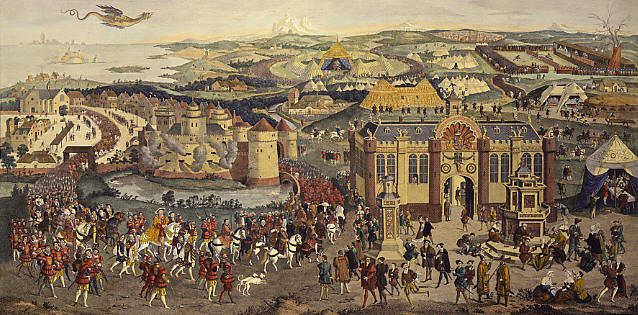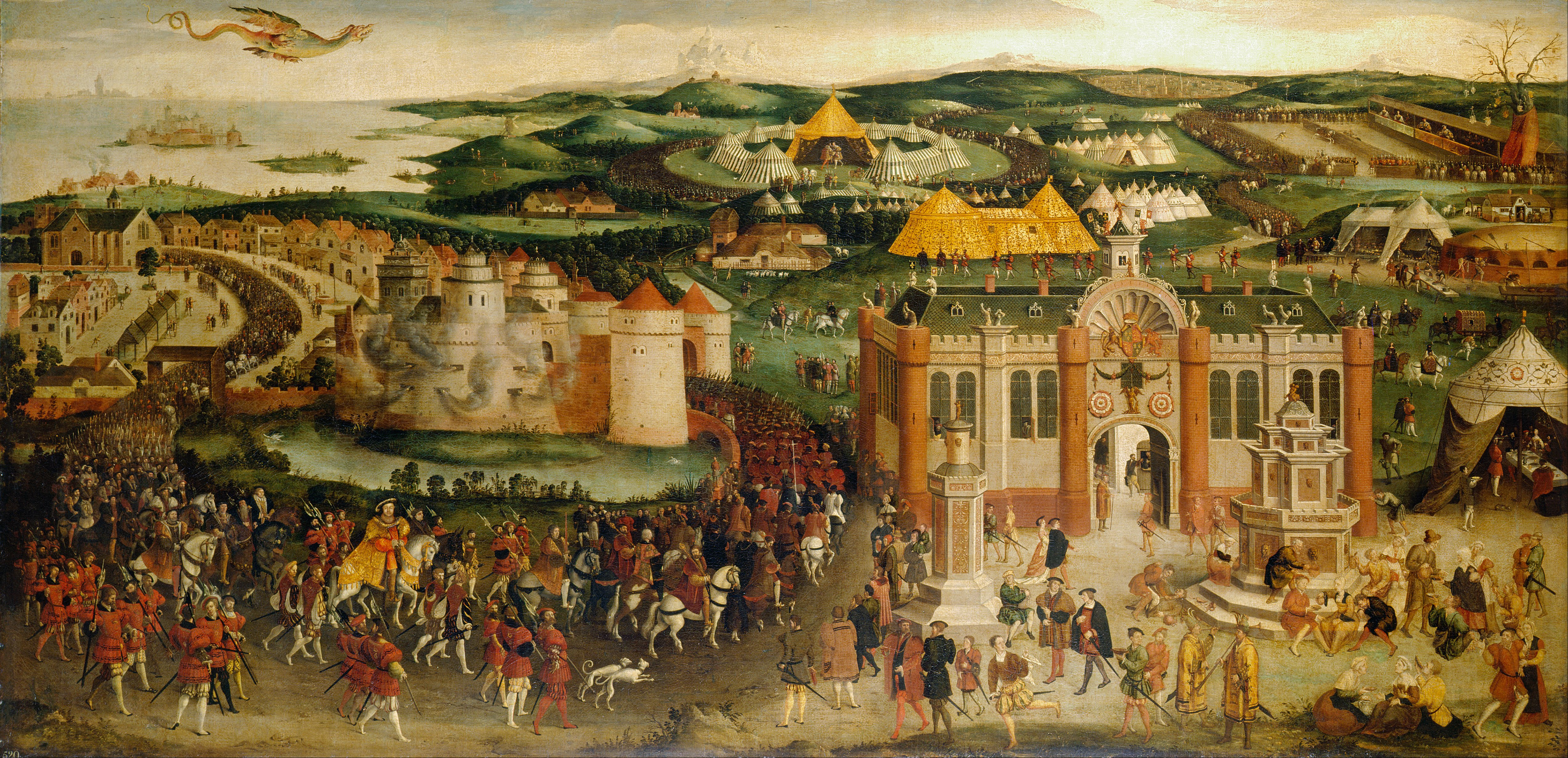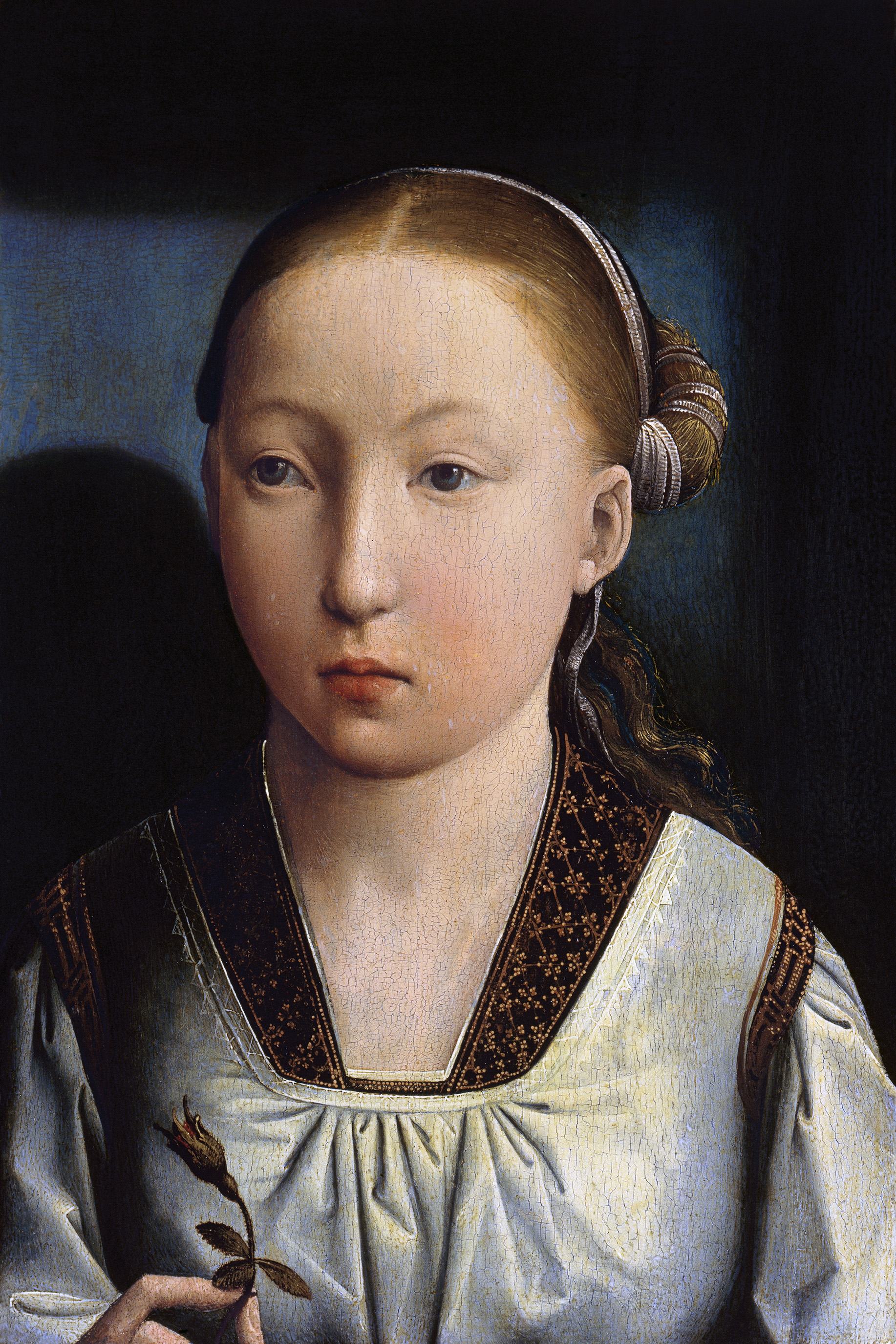|
Ralph Neville, 4th Earl Of Westmorland
Ralph Neville, 4th Earl of Westmorland KG (21 February 1498 – 24 April 1549), was an English peer and soldier. He was the grandson of Ralph Neville, 3rd Earl of Westmorland, and the father of Henry Neville, 5th Earl of Westmorland. Family Ralph Neville, born 21 February 1498, was the son of Ralph Neville (d. 1498) and Edith Sandys (d. 22 August 1529), daughter of Sir William Sandys of the Vyne by Edith Cheyne, daughter of Sir John Cheyne. He was the grandson of Ralph Neville, 3rd Earl of Westmorland, and Isabel Booth. Neville had a brother who died young, and a sister, Isabel, who married firstly, Sir Robert Plumpton, and secondly, Lawrence Kighley, Esq. Another sister, Cecilia, married John Weston and was the mother of Robert Weston. After his father's death in 1498, Neville's mother, Edith, married Thomas Darcy, 1st Baron Darcy of Darcy, who was beheaded on Tower Hill 30 June 1537 for his part in the Pilgrimage of Grace. She died at Stepney on 22 August 1529, and was ... [...More Info...] [...Related Items...] OR: [Wikipedia] [Google] [Baidu] |
Earl Of Westmorland
Earl of Westmorland is a title that has been created twice in the Peerage of England. The title was first created in 1397 for Ralph Neville, 1st Earl of Westmorland, Ralph Neville. It was forfeited in 1571 by Charles Neville, 6th Earl of Westmorland, for leading the Rising of the North. It was revived in 1624 in favour of Francis Fane, 1st Earl of Westmorland, Sir Francis Fane, whose mother, Mary Neville, was a descendant of a younger son of the first Earl. The first Earl of the first creation had already become Baron Neville de Raby, and that was a subsidiary title for his successors. The current Earl holds the subsidiary title Baron Burghersh (1624). 1397 creation Ralph Neville, 4th Baron Neville of Raby, and 1st earl of Westmorland (1364–1425), eldest son of John, 3rd Baron Neville, and his wife Maud Percy (see Neville, ''Family''), was knighted by Thomas of Woodstock, 1st Duke of Gloucester, Thomas of Woodstock, afterwards duke of Gloucester, during the Thomas of Woodstock ... [...More Info...] [...Related Items...] OR: [Wikipedia] [Google] [Baidu] |
Field Of The Cloth Of Gold
The Field of the Cloth of Gold (, ) was a summit meeting between King Henry VIII of England and King Francis I of France from 7 to 24 June 1520. Held at Balinghem, between Ardres in France and Guînes in the English Pale of Calais, it was an opulent display of wealth by both kings. The summit was arranged to increase the bond of friendship between the two kings following the Anglo-French treaty of 1514. The two monarchs would meet again in 1532 to arrange Francis's assistance in pressuring Pope Clement VII to pronounce Henry's first marriage as illegitimate. Under the guidance of English Cardinal Thomas Wolsey, these European states sought to outlaw war forever among Christian peoples. The Pale of Calais, home to the meeting in Balinghem, was the final English possession in France. This territorial leftover from the Hundred Years' War caused some tensions between the English and French, as the latter preferred a location closer to the border, but topographical considerati ... [...More Info...] [...Related Items...] OR: [Wikipedia] [Google] [Baidu] |
William Dacre, 3rd Baron Dacre
William Dacre, 7th Baron Greystock, later 3rd Baron Dacre of Gilsland (c. 1493 – 18 November 1563) was an English peer, a Cumberland landowner, and the holder of important offices under the Crown, including many years' service as Warden of the West Marches. Life The son of Thomas Dacre, 2nd Baron Dacre, by his marriage to Elizabeth Greystoke, Dacre succeeded his mother as Baron Greystock on 14 August 1516 and his father as Baron Dacre in 1525."Dacre of Gilsland, Baron (E, 1473 - abeyant 1569)" ''Cracroft's Peerage''. From his father, he inherited about of land in Cumberland, in and in |
Catherine Of Aragon
Catherine of Aragon (also spelt as Katherine, historical Spanish: , now: ; 16 December 1485 – 7 January 1536) was List of English royal consorts, Queen of England as the Wives of Henry VIII, first wife of King Henry VIII from their marriage on 11 June 1509 until its annulment on 23 May 1533. She was Princess of Wales while married to Henry's elder brother, Arthur, Prince of Wales, for a short period before his death. Catherine was born at the Archbishop's Palace of Alcalá de Henares, and was the youngest child of Isabella I of Castile and Ferdinand II of Aragon. She was three years old when she was betrothed to Arthur, the eldest son of Henry VII of England. They married in 1501, but Arthur died five months later. Catherine spent years in limbo, and during this time, she held the position of ambassador of the Aragonese crown to Kingdom of England, England in 1507, the first known female ambassador in European history. She married Henry VIII shortly after his accession i ... [...More Info...] [...Related Items...] OR: [Wikipedia] [Google] [Baidu] |
Pope Clement VII
Pope Clement VII (; ; born Giulio di Giuliano de' Medici; 26 May 1478 – 25 September 1534) was head of the Catholic Church and ruler of the Papal States from 19 November 1523 to his death on 25 September 1534. Deemed "the most unfortunate of the popes", Clement VII's reign was marked by a rapid succession of political, military, and religious struggles—many long in the making—which had far-reaching consequences for Christianity and world politics. Elected in 1523 at the end of the Italian Renaissance, Clement came to the papacy with a high reputation as a statesman. He had served with distinction as chief advisor to Pope Leo X (1513–1521, his cousin), Pope Adrian VI (1522–1523), and commendably as gran maestro of Florence (1519–1523). Assuming leadership at a time of crisis, with the Protestant Reformation spreading, the Church nearing bankruptcy, and large foreign armies invading Italy, Clement initially tried to unite Christendom by making peace among the m ... [...More Info...] [...Related Items...] OR: [Wikipedia] [Google] [Baidu] |
Henry FitzRoy, Duke Of Richmond And Somerset
Henry FitzRoy, Duke of Richmond and Somerset (c. 15 June 1519 – 23 July 1536) was the son of Henry VIII of England and his mistress Elizabeth Blount, and the only child born out of wedlock whom Henry acknowledged. He was the younger half-brother of Mary I, as well as the older half-brother of Elizabeth I and Edward VI. Through his mother, he was the elder half-brother of Elizabeth, George, and Robert Tailboys. His surname means "son of the king" in Norman French. Birth Henry FitzRoy was born in June 1519. His mother was Elizabeth Blount, Catherine of Aragon's lady-in-waiting, and his father was Henry VIII. FitzRoy was conceived when Queen Catherine was approaching her last confinement with another of Henry's children, a stillborn daughter born in November 1518. To avoid scandal, Blount was taken from Henry's court to the Augustinian priory of St Laurence at Blackmore near Ingatestone, in Essex. FitzRoy's birthdate is often given as 15 June 1519, but the exac ... [...More Info...] [...Related Items...] OR: [Wikipedia] [Google] [Baidu] |
Scottish Marches
Scottish Marches was the term used for the Anglo-Scottish border during the Late Middle Ages and the Early Modern era, characterised by violence and cross-border raids. The Scottish Marches era came to an end during the first decade of the 17th century following the Union of the Crowns of England and Scotland. History Origins The Marches were first conceived in a treaty between Henry III of England and Alexander III of Scotland in 1249 as an attempt to control the Anglo-Scottish border by providing a buffer zone. On each side of the Anglo-Scottish border there was the West March, the Middle March and the East March. These regions nearly mirrored each other but there was some overlap between the Scottish and English regions. In the late 13th century Edward I of England appointed the first Lord Warden of the Marches, who was tasked with overseeing these regions and keeping their monarch's domain secure; when it was in their interests, they would encourage cross-border raid ... [...More Info...] [...Related Items...] OR: [Wikipedia] [Google] [Baidu] |
Lord Warden Of The Marches
The Lord Warden of the Marches was an office in the governments of Scotland and England. The holders were responsible for the security of the border between the two nations, and often took part in military action. They were also responsible, along with Conservators of the Truce, for administering the special type of border law known as March law. The Marches on both sides of the border were traditionally split into West, Middle, and East, each with their own warden answerable to the Lord Warden-general. The English Western March was based on Carlisle and the Eastern March on Berwick-upon-Tweed. The offices became unnecessary after the union of the crowns of England and Scotland under King James in 1603. For England Warden of the Marches * Robert de Clifford (1297–) (died 1314) * John de Warenne, 7th Earl of Surrey (1327–) * Henry de Percy, 2nd Baron Percy (1328–) * Ralph Neville, 2nd Baron Neville de Raby and Henry de Percy, 2nd Baron Percy (1334–) (jointly) * Gi ... [...More Info...] [...Related Items...] OR: [Wikipedia] [Google] [Baidu] |
Berwick-upon-Tweed
Berwick-upon-Tweed (), sometimes known as Berwick-on-Tweed or simply Berwick, is a town and civil parish in Northumberland, England, south of the Anglo-Scottish border, and the northernmost town in England. The 2011 United Kingdom census recorded Berwick's population as 12,043. The town is at the mouth of the River Tweed on the east coast, south east of Edinburgh, north of Newcastle upon Tyne, and north of London. Uniquely for England, the town is slightly further north than Denmark's capital Copenhagen and the southern tip of Sweden, further east of the North Sea, which Berwick borders. Berwick was founded as an Anglo-Saxon settlement in the Kingdom of Northumbria, which was annexed by England in the 10th century. A civil parishes in England, civil parish and town council were formed in 2008 comprising the communities of Berwick, Spittal, Northumberland, Spittal and Tweedmouth. It is the northernmost civil parish in England. For more than 400 years, the area was central t ... [...More Info...] [...Related Items...] OR: [Wikipedia] [Google] [Baidu] |
Privy Council (United Kingdom)
The Privy Council, formally His Majesty's Most Honourable Privy Council, is a privy council, formal body of advisers to the sovereign of the United Kingdom. Its members, known as privy counsellors, are mainly senior politicians who are current or former members of either the House of Commons of the United Kingdom, House of Commons or the House of Lords. The Privy Council formally advises the sovereign on the exercise of the Royal prerogative in the United Kingdom, royal prerogative. The King-in-Council issues Executive (government), executive instruments known as Orders in Council. The Privy Council also holds the delegated authority to issue Orders of Council, mostly used to regulate certain public institutions. It advises the sovereign on the issuing of royal charters, which are used to grant special status to incorporated bodies, and city status in the United Kingdom, city or Borough status in the United Kingdom, borough status to local authorities. Otherwise, the Privy Co ... [...More Info...] [...Related Items...] OR: [Wikipedia] [Google] [Baidu] |
Earl Of Surrey
Earl of Surrey is a title in the Peerage of England that has been created five times. It was first created for William de Warenne, a close companion of William the Conqueror. It is currently held as a subsidiary title by the Dukes of Norfolk. The chequer arms of the Count of Vermandois were first adopted by William de Warenne, 2nd Earl of Surrey on his marriage to Elizabeth of Vermandois, Countess of Leicester, daughter to Hugh, Count of Vermandois. Similar arms were also adopted by his brother in law, the famous Crusader Ralph I de Beaugency who had married an older sister, Matilda. These arms continue to be used as the Flag of Surrey. History The Earldom of Surrey was first created in 1088 for William de Warenne, as a reward for loyal service to William during the Conquest. He received the lordship of Reigate Castle in Surrey, but also had holdings in twelve other counties. Perhaps because he held little property in Surrey, the earldom came to be more commonly ... [...More Info...] [...Related Items...] OR: [Wikipedia] [Google] [Baidu] |
Thomas Howard, 3rd Duke Of Norfolk
Thomas Howard, 3rd Duke of Norfolk, (10 March 1473 – 25 August 1554) was an English politician and nobleman of the Tudor era. He was an uncle of two of the wives of King Henry VIII, Anne Boleyn and Catherine Howard, both of whom were beheaded, and played a major role in the machinations affecting these royal marriages. After falling from favour in 1546, Norfolk was stripped of his dukedom and imprisoned in the Tower of London, avoiding execution when Henry VIII died on 28 January 1547. He was released on the accession of the Roman Catholic Queen Mary I, whom he aided in securing the throne, thus setting the stage for tensions between his Catholic family and the Protestant royal line that would be continued by Mary's half-sister, Elizabeth I. Early life Thomas was the son of Sir Thomas Howard, later 2nd Duke of Norfolk (1443–1524), by his first wife, Elizabeth Tilney (died 1497), the daughter of Sir Frederick Tilney and widow of Sir Humphrey Bourchier, and the gr ... [...More Info...] [...Related Items...] OR: [Wikipedia] [Google] [Baidu] |






